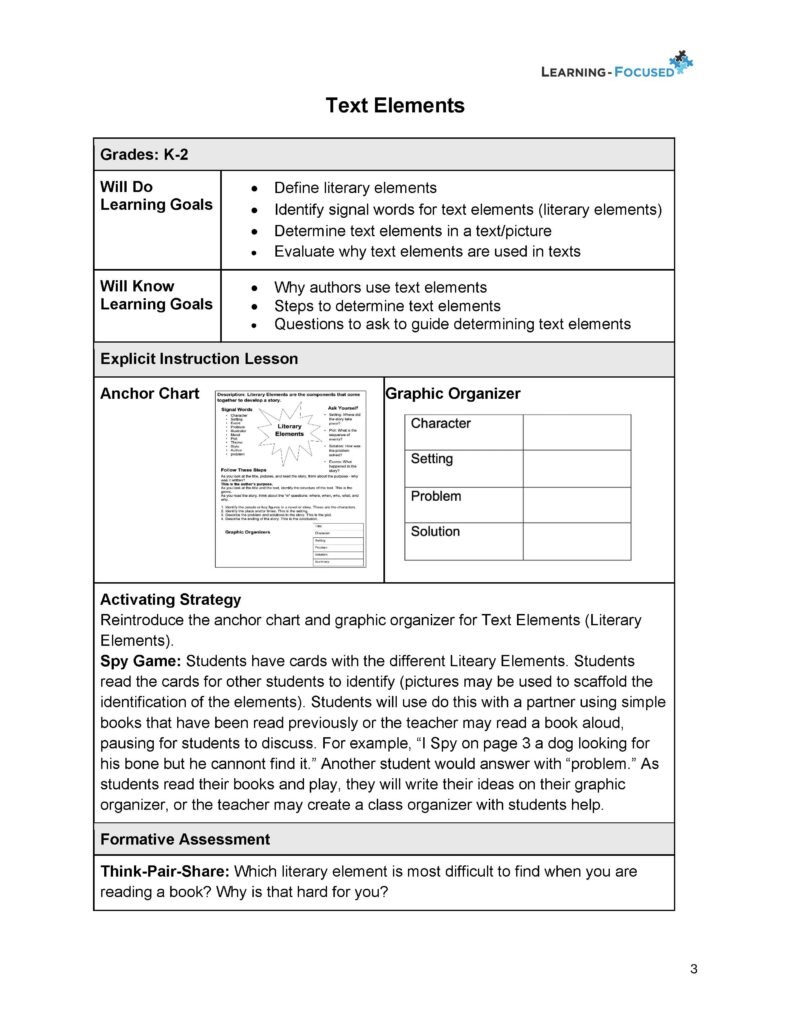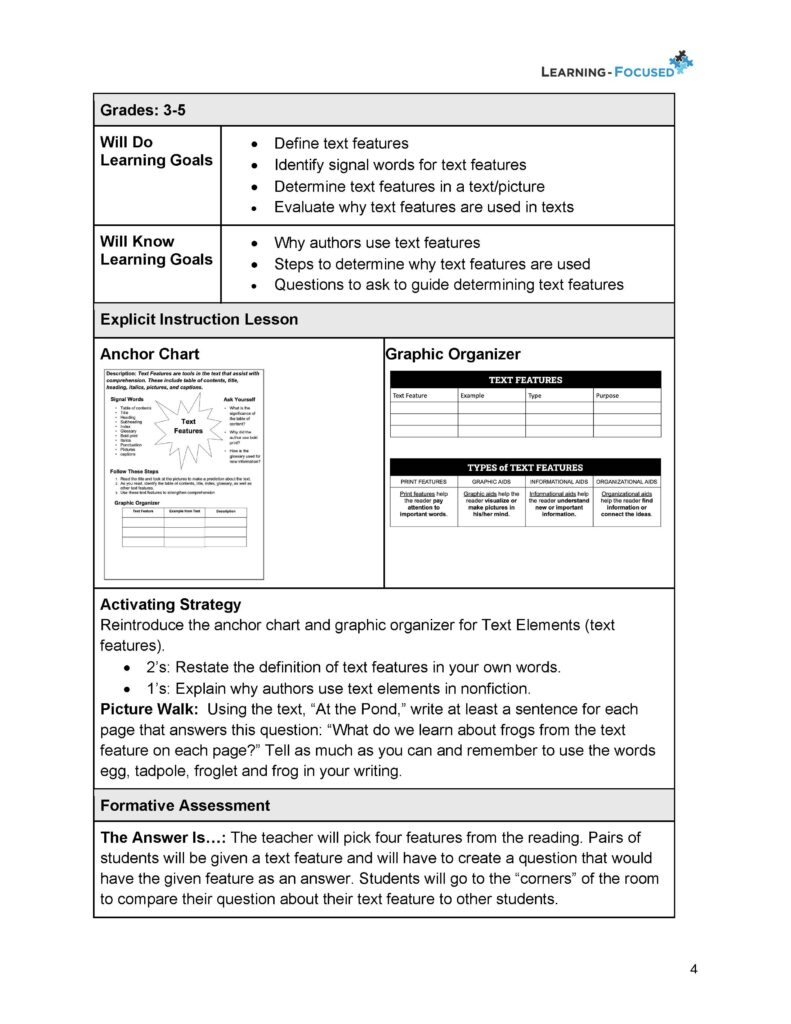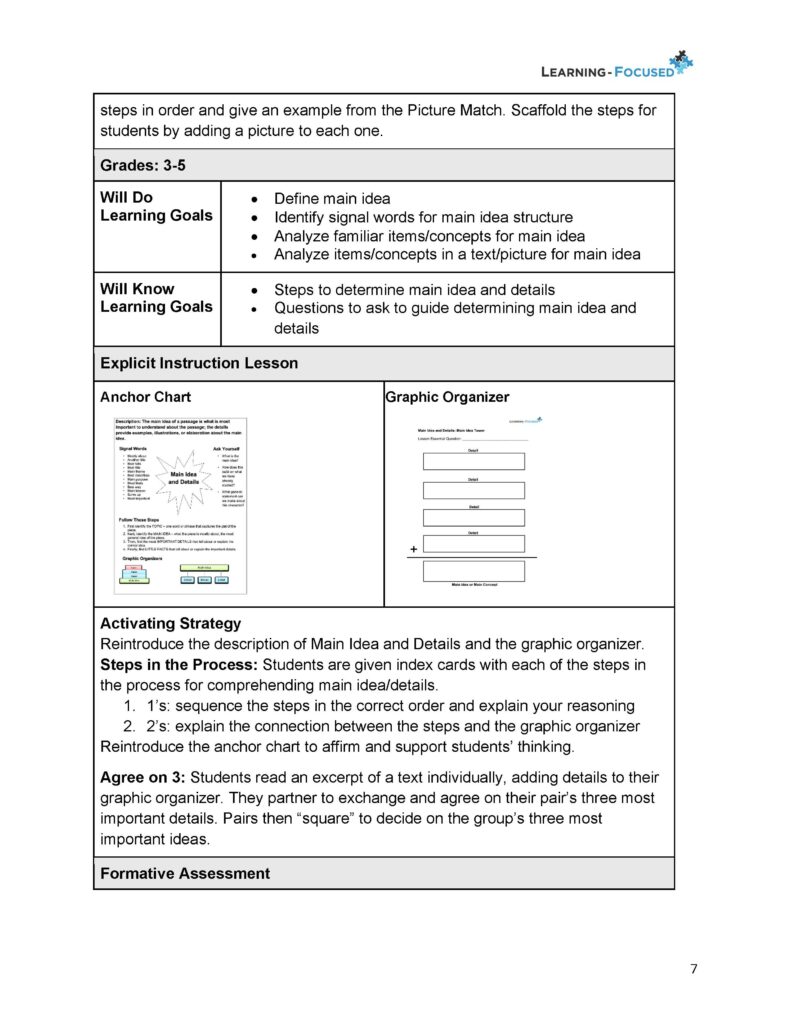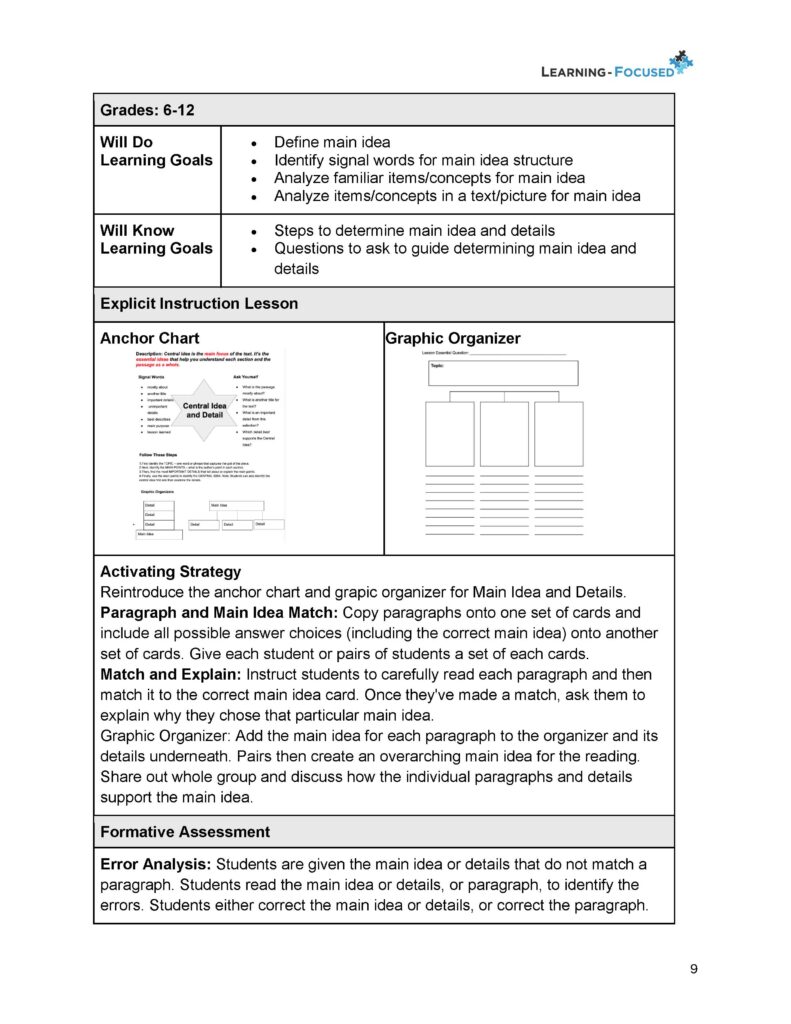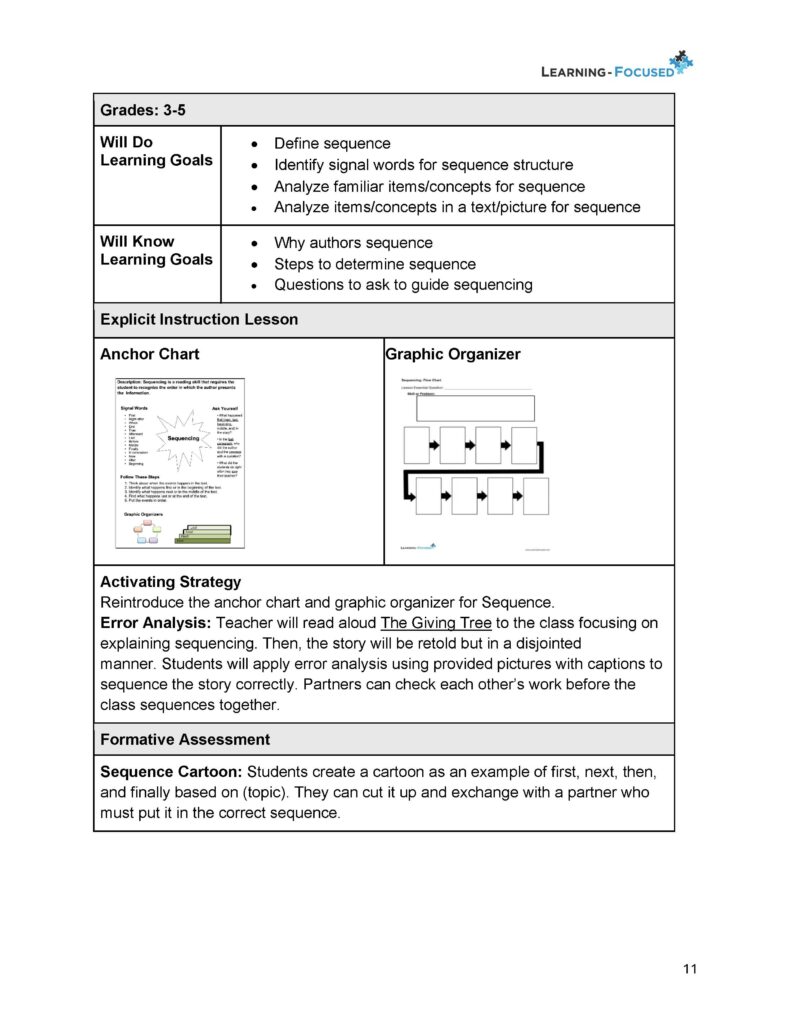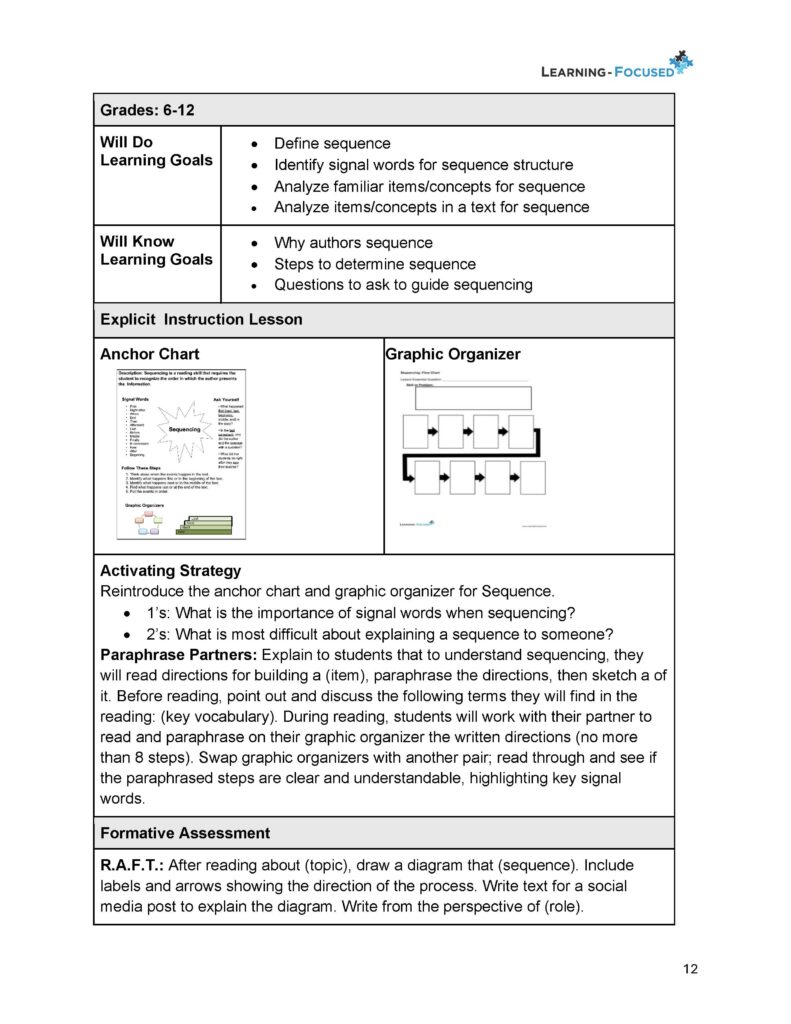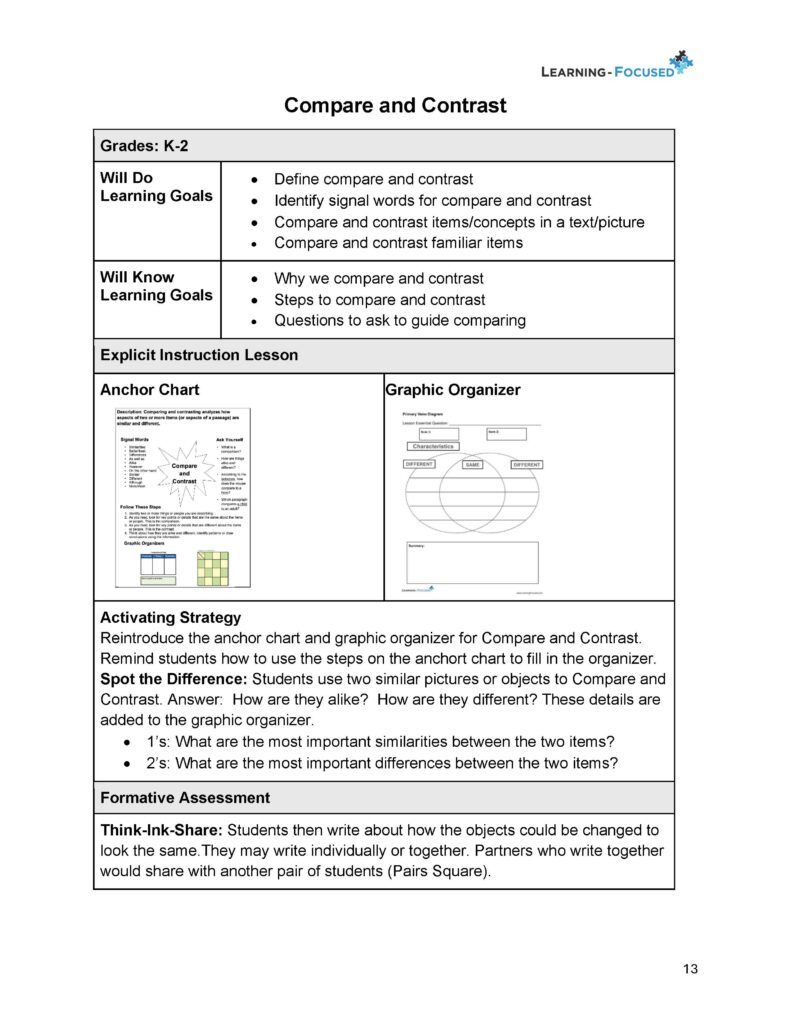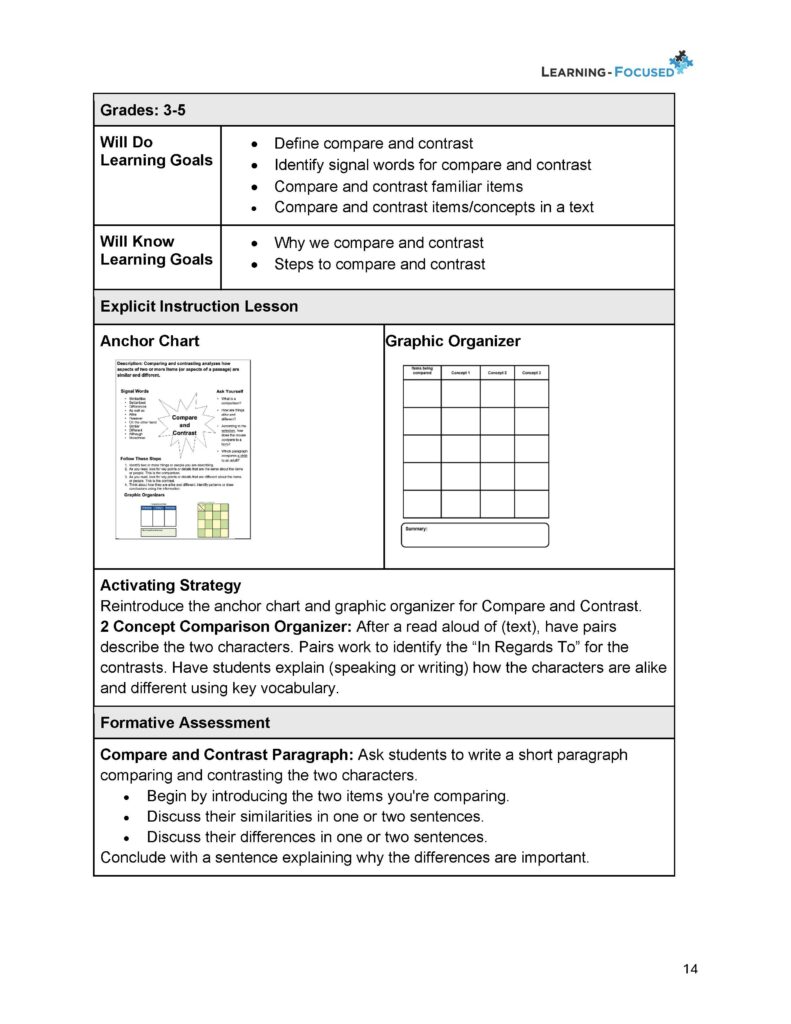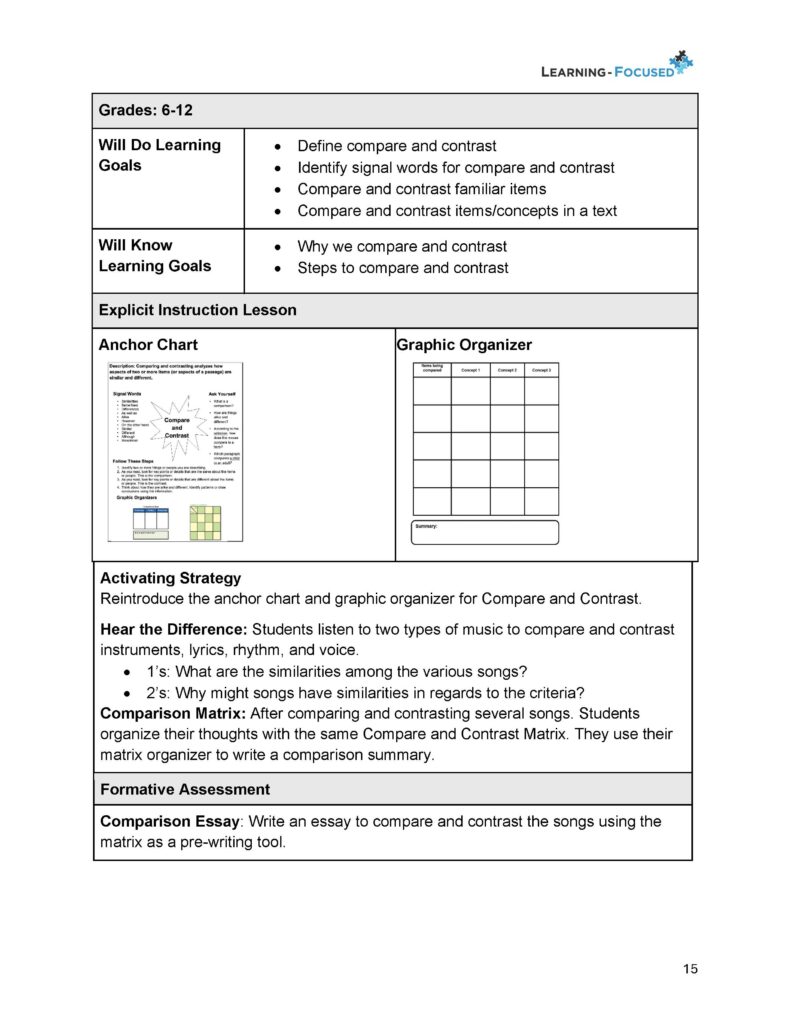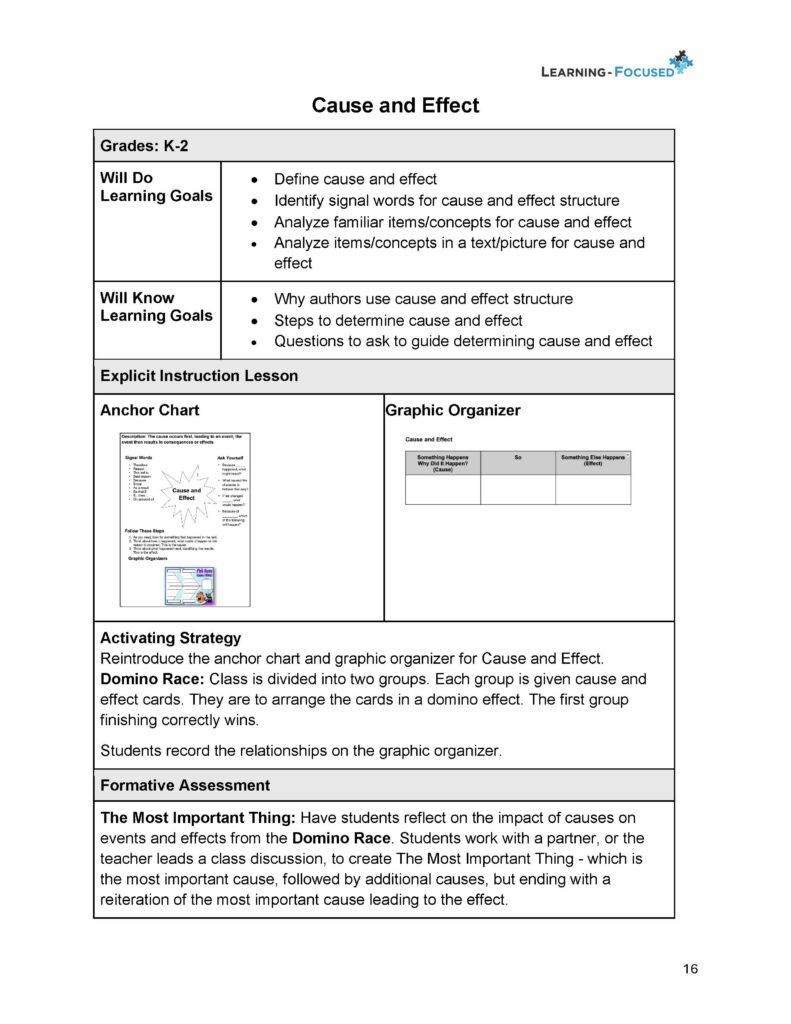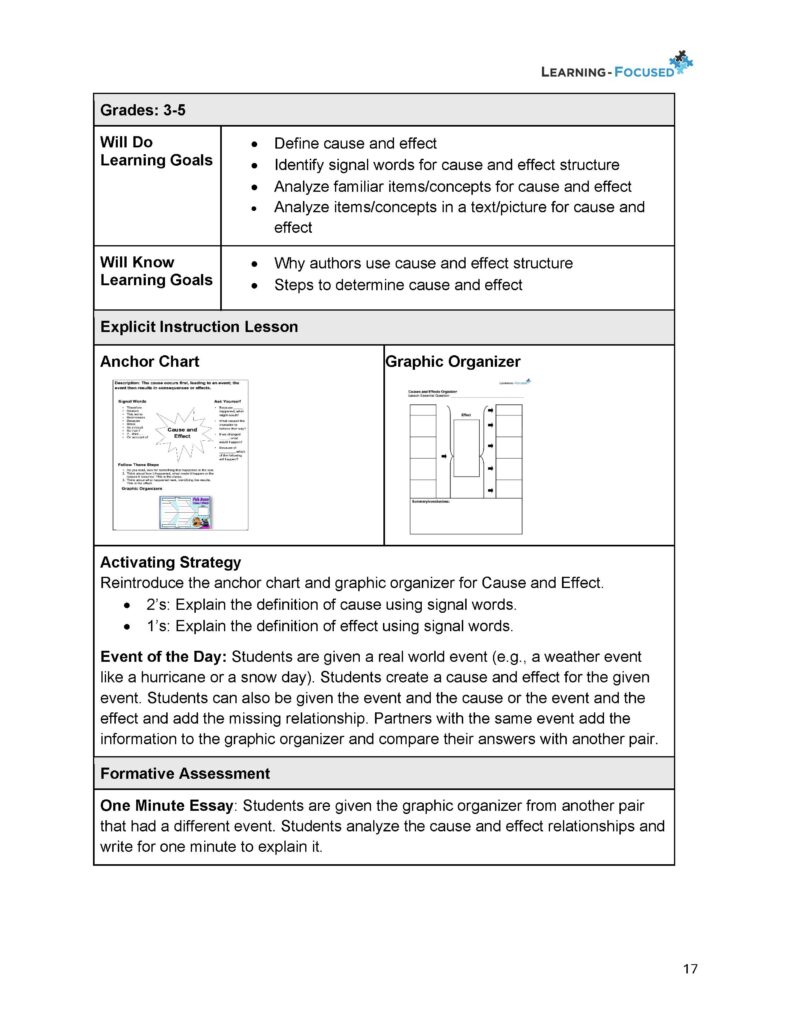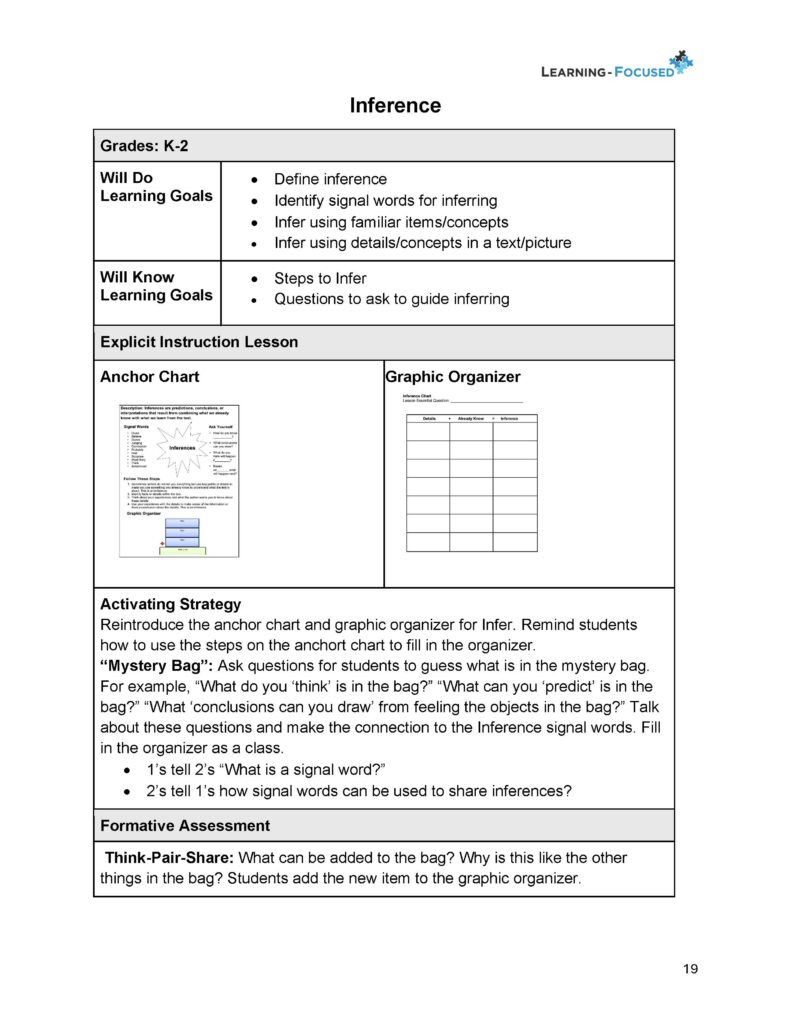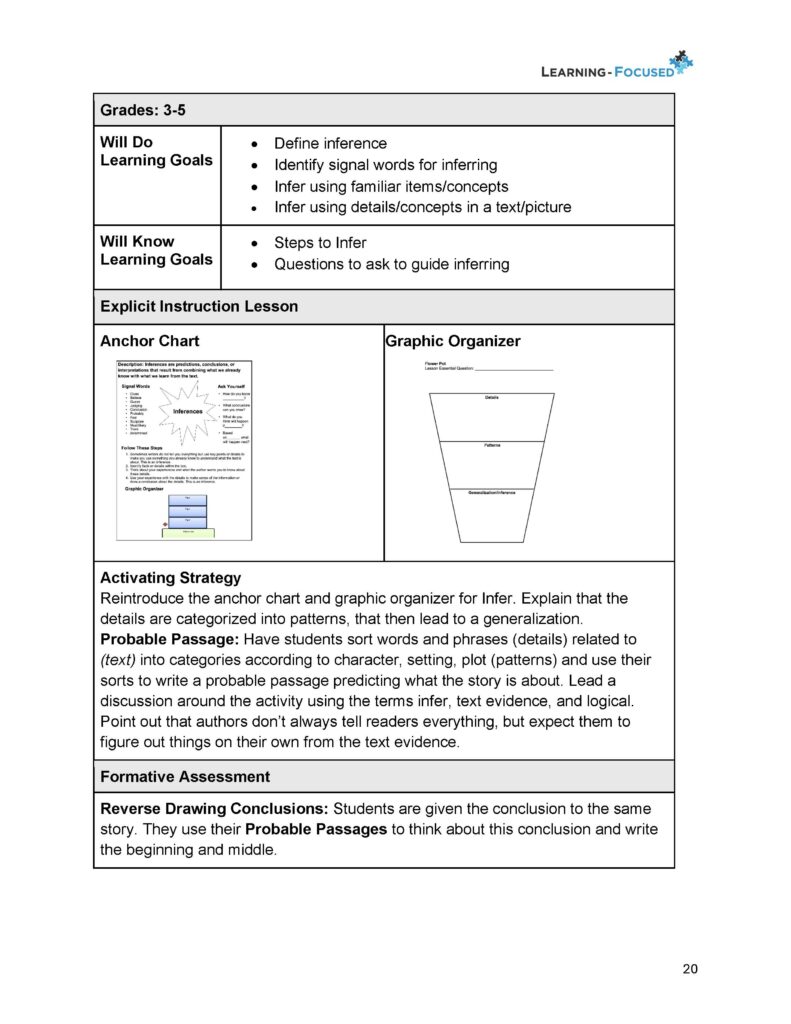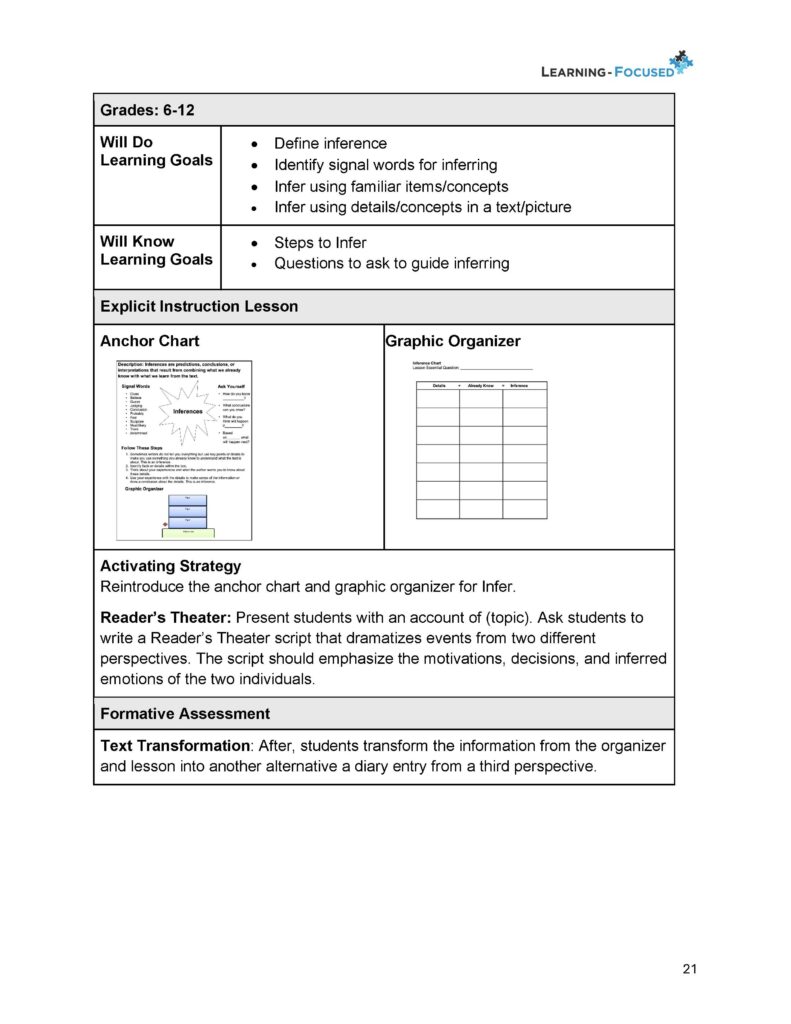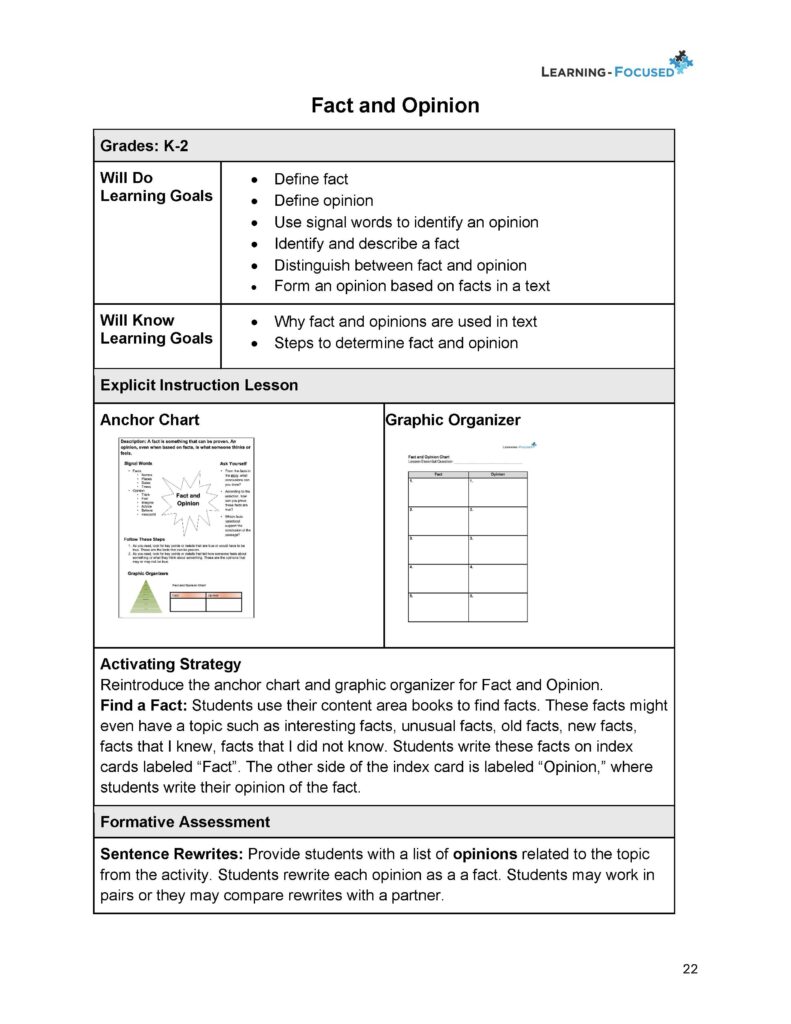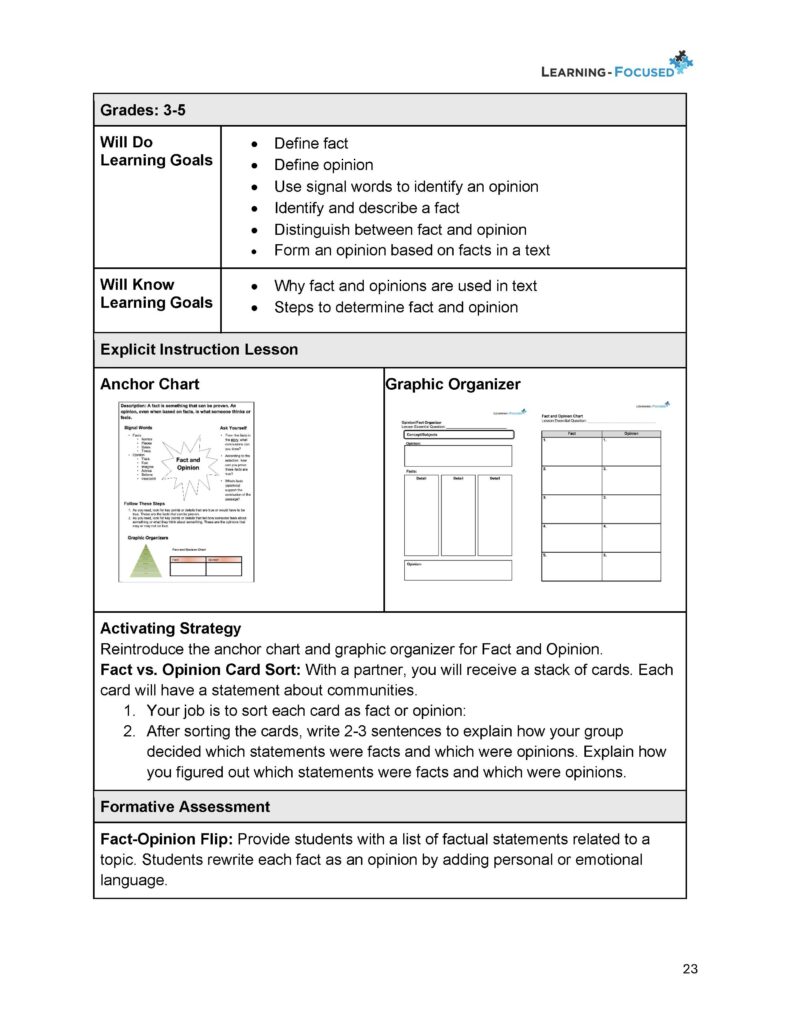Increase Critical Thinking with Comprehension Strategies Resources
These additional resources are provided for you to expand your Comprehension Strategies toolbox.
Bookmark this page in your browser so that you can return it as needed.
Additional Example Activities
Activating Strategies
| Learning Goal | Activating Strategy |
| Recognize the important aspects of key literary elements | Frayer Organizer Match: Create a Frayer organizer with each of the Literary Elements: character, setting, problem and solution. Once complete, cut up the Frayer organizer to make a matching game. Each Frayer has 5 pieces, so with the 4 Frayers there will be 20 pieces to put together. This could be the vocabulary activity during whole group or small group. Afterwards put them in a baggie or folder to be practiced in centers. |
| Describe the literary elements of a story | Literary Elements Story Chains: Give students four strips of construction paper. Students write character, setting, problem and solution on individual strips. They paste these strips together to create a story chain. Additional chains can be added for title, author, illustrator, mood, plot, or theme. These make a great display in the room or halls. |
| Recognize text elements and their examples | 3x4 Puzzle: Students match adjacent sides of puzzle pieces using text features and examples. Students may create the puzzle, before cutting the puzzle apart and asking other pairs to reassemble it so adjacent sides match. |
| Analyze the relationship among text features and their role in identifying Main Idea and Details | What’s My Rule? Distribute a text to each student or pair of students. Ask students to identify the different text features present in the text. They can use sticky notes or index cards to label each feature. Have students categorize the text features based on their function in helping to determine the main idea or key details. For example, headings and subheadings often indicate the main idea, while boldface text or italics might highlight important details. Facilitate a class discussion to explore the different categories of text features and how they contribute to understanding the text. Ask students to provide examples from the text to support their analysis.Together, create a general rule or statement about how text features can be used to identify the main idea and key details of a text.
Example Rule: Headings and subheadings often provide clues to the main idea of a text, while boldface text, italics, and captions can highlight important details. |
Formative Assessments
| Learning Goal | Formative Assessment |
| Analyze when a text feature would be impactful in the text | Present students with an informational text, but remove the text features. Students read the text (5-8 minutes).
Think, Ink, Share: “What text feature may have been helpful for the author to include in this text and why?” |
| Identify the characteristics of literary texts | 3-2-1: Using the anchor chart and graphic organizer as a guide explain:
List 1 type of literary text. |
| Explain the purposes of text features | The Answer Is…: The teacher will pick several of the nonfiction text features that the students located in the lesson. Each student will be given a text feature and will have to create a question that would have the given feature as an answer. Students may partner or work in groups to pass their questions in order to compile together as many questions as possible for each text feature.
Example: The answer is a caption. Sample Response: “What nonfiction text feature describes a photograph or illustration in a text?” Or “What nonfiction text feature provides information about photographs or illustrations in a text?” |
| Predict the most important ideas and details in a text by previewing text features | Dear Absent Student: Write a letter to an absent student explaining the relationship between previewing text features and reading comprehension. Include three types of text features in your letter. |
Learning Activities
| Learning Goal | Learning Activity |
| Identify key text features in a variety of informational texts | Collage: Students use the newspaper, magazines, or any other type of text to create a collage with the different text features. Students share and/or display their collage. |
| Locate specific text features in a variety of texts | I Spy Game: Students have cards with the different Text Features. Students read the cards for other students to identify. For example, “I Spy in the back of the book a definition of important words.” Another student would answer with “glossary.” |
| Analyze when a text feature would be impactful in the text | Odd One Out: Students are given a text and a list of text features to justify including in the text. Students justify why to include three of the four and why not to include one of the four. |
Assignments
| Learning Goal | Assignments |
| Use text features to organize information about the seasons | All About Book: Students create an information book about seasons with examples of Text Features. This book can be made by folding several pages in half and stapling at the fold. On the left side, students write the Text Feature and a description. On the right side, students create an example of the Text Feature. This could be student created, computer created, or cut out of a newspaper or magazine. |
| Explain the purpose and function of various text features commonly used in math textbooks | Brochure: Create a mini-brochure that highlights various text features commonly found in math textbooks. Use as a visual aid for students to understand the purpose and function of each text feature and how it can be applied to math concepts. Students fold several sheets of paper in half to create a stapled booklet. On the left side of each page, students write the name of a specific text feature. On the right side, a brief description of the text feature, explaining its purpose and how it is used in math. Students create or find examples of each text feature related to math concepts.
Example: A bar graph showing the number of students in each grade level |
| Preview a text’s features to predict what its main ideas may be about | Preview a chapter in your science book. Create a matrix organizer to explain the how text features support comprehension using evidence from the text. Predict what the chapter is mostly about based on your preview. |
| Analyze how elements of a short story (characters, setting and tone) support the theme development | Ray Bradbury paints a picture of a futuristic society. Using details from the story, construct a written argument that supports how the author uses literary elements (characters, setting, tone) to support the theme of “The Veldt.
More Challenge: Determine which element used by the author contributes the most toward the development of the theme in the story and construct an argument that supports your ideas. Be sure to include evidence as to why the other elements used are less significant regarding the development of the theme. |
Activating Strategies
| Learning Goal | Activating Strategy |
| Recognize the connections between main ideas and supporting details | Main Idea and Detail Match: This activity has a main idea on one card and a detail on another. Students match the main idea with the detail.
Example: Main Idea: There are four seasons in a year. |
| Differentiate between main ideas and supporting details | Main Idea Envelope Please: Give students envelopes with either a supporting detail for a main idea on the front. Inside will be a card with the correct response folded so it cannot be seen through the envelope. Have the students go around the room and see whose envelopes belong with their group. Once the students have found their group, they are to read their envelope and discuss which one is the supporting detail and the main idea. They are to give reasons for their choices. Then, they should say which one they think they have (supporting detail, or main idea. Once the prediction has been made, the teacher announces, "The Envelope Please." This is the signal for the students to open their envelope and see if their predictions were correct. |
| Identify the main idea and supporting details in a text | Read Aloud: Read The Important Book, by Margret Wise Brown. While reading, use think aloud to share needed information about Main Idea and Details. Ask students to choose an object and write about it in order to add it to the book. |
| Describe relationships between lines, angles, and shapes in two-dimensional and three-dimensional figures | A Picture is Worth a 1,000 Words: Create a series of images that contain different shapes, and line and angle relationships (these may contain man-made items such as buildings and clothing, or they may also be pictures of landscapes and items of nature). Create a chart for students to record their findings as they view the images. Students look for relationships between lines, angles, types of 2-D or 3-D figures during viewing. Numbered Heads Discussion: 1’s tell 2’s: What are the important parts (or details) of the images? 2’s tell 1’s: What are the unimportant parts (or details)? |
Formative Assessments
| Learning Goal | Formative Assessment |
| Infer the main idea of a given paragraph | Paragraph and Main Idea Match: Prepare the Cards: • Option 1 (Easier): Copy paragraphs and their corresponding main ideas from a science textbook or workbook onto separate index cards or strips of paper. • Option 2 (More Challenging): Copy paragraphs onto one set of cards and include all possible answer choices (including the correct main idea) onto another set of cards. Distribute Cards: Give each student a paragraph card and a main idea card (or answer choice cards in Option 2). Match and Explain: Instruct students to carefully read the paragraph and then match it to the correct main idea card (or choose the best answer from the available options). Once they've made a match, ask them to explain why they chose that particular main idea. |
| Explain the steps in the process for determining Main Idea and Details | Steps in the Process: Students are given index cards with each of the steps in the process for comprehending Main Idea and Details. Students put these steps in order and give an example of each. The example might be something the students have read, heard, or viewed. This is a great activity to put in a baggie for a group activity. It can also be placed in a Comprehension Center to reinforce student understanding. |
| Infer the main idea of an illustration | Name That Title: Students are given a picture of a cover of a book, or just a picture (it does not have to be a book cover). The title is covered up so the students can not see it. Students are to look at the picture and create a title that could go with the cover. Another suggestion is to give students a summary of the book and then they draw a cover page and create the title. |
| Evaluate the main idea or details for errors | Error Analysis: Students are given a Main Idea or Details that does not match the paragraph. Students read the Main Idea, or Details, or paragraph and identify the errors. Students either correct the Main Idea or Details, or correct the paragraph. |
Learning Activities
| Learning Goal | Learning Activity |
| Evaluate the details of a text to determine the most important | Agree on 3: Students read individually, then select their three most important ideas from their graphic organizer. They partner to exchange and agree on their pair’s three most important ideas. The pairs then “square” (join another pair) to decide on the group’s three most important ideas. Finally, the class as a whole can agree on the three most important ideas. |
| Describe the life cycle of a frog using important details to describe each stage | Important and Unimportant Details: Students have a paragraph to read. There are important and unimportant Details written on cards. Students sort the important Details from the unimportant Details. Important Details Once there was a frog that lived in a pond at the park The frog started life as an egg in the pond The egg hatched into a tadpole In time the tadpole grew back legs, then front legs Over time the tail became shorter and the tadpole became a frog The frog lived on the land and swam in the pondUnimportant Details The park was located on Maple Street in the town of Yellowstone An Oak Tree provided shade for the eggs The tadpole lived in danger of being eaten |
| Analyze images to explain its historical context and perspective | Create a Caption: Choose a set of historical images that are relevant to the lesson’s content. Divide the class into small groups and provide each group with a different historical image. Students carefully analyze the image and create a caption that accurately describes the scene, identifies the people or objects involved, and explains its historical significance. Support analysis with key details. |
| Determine the main topic and details for images | Main Topic and Detail Picture Match: Using cards with pictures and cards with matching Main Ideas and Details students look at the pictures and predict the Main Idea and Details. They match the picture with the correct Main Idea and Detail card. This activity could have separate cards for the Main Ideas and different cards for the Details. Students could match three cards, one for the picture, one for the Main Idea and one for the matching Detail. This could also be an activity that matches a picture with its caption. |
Assignments
| Learning Goal | Assignments |
| Retell story events using key details | During independent reading students will use colored sticky notes to identify details and main topic in a text. The students will then use their sticky notes to fill in the graphic organizer for this lesson. They will use the graphic write the main idea of the passage as well as two details that support that main idea.
Differentiated Assignment for Struggling Students: The main idea of the text is ___. One key detail that supports this idea is ______. Another key detail that supports the main idea is _______. |
| Write a paragraph that recounts the key details of the text and explain how these details support the main idea. | After reading a grade level informational text, students will use their Main Idea Tower organizer to identify and highlight the key details in the text and recount the key details to determine the main idea. Students will write a paragraph to recount the key details and explain how the key details support the main idea.
Differentiated Assignment for Struggling Students: |
| Analyze the relationship between the central idea and key details | Imagine that you are an advice columnist. Answer a letter from a reader who would like advice on how to cure glossophobia. Use your graphic organizer to identify details about the cure for glossophobia. Decide which suggestions you will advise the reader to use. Cite text evidence to support your suggestions. |
| Analyze the relationship between the central idea and the development of its supporting details | After reading the Cultural Belongings passage set, answer the following question: What is the impact of culture on a person’s identity? Write an editorial for a news organization’s online platform that states your answer, and support your answer with text evidence. Be sure to clearly explain your reasoning. Consider the central idea of each passage and how the details work together to build an argument for how culture influences identity? |
Activating Strategies
| Learning Goal | Activating Strategy |
| Use context clues to sequence a passage | Cut Up Passage: Cut up a passage and put the parts in a baggie. These cuts are determined by the level of the students. Most teachers cut at each paragraph. It is suggested to double cut the parts because students sometimes put the “cut lines” together without even reading the parts. Pairs or groups of students are given a baggie. They take out each part and read them to put them in order. Students reread to make sure the passage makes sense. Questions could be added to match the answers with where they found the answers. Great activity to strengthen students’ ability to look back in the passage for answers. |
| Explain the sequence of steps in a process | Recipe Book: Students create their favorite recipes. They make the Students create their favorite recipes. They make the connection to sequencing by using signal words to identify the steps for gathering ingredients, mixing, and baking. Students can put these recipes together for a class recipe book. |
| Explain the characteristics of an autobiography | “Who Am I”: Write a brief autobiography of your life. Students will work in small groups to guess which one belongs to which group member. Explain to the group why you included certain details. |
| Predict the outcome of following a series of directions | “What Am I”: Read a short “how to” set of instructions, one step at a time. Students listen to each step and decide what the directions will help them build.
Example: Cut six 5 x 5 rectangles out of wood. Nail the rectangles together to form a box. Cut a hole in the front of the box. Nail a 5” dowel under the hole. Nail a hook or rope for hanging. Hang the box outside.
Discuss how difficult it would be to build the birdhouse if the directions were out of order and introduce the word sequencing. |
Formative Assessments
| Learning Goal | Formative Assessment |
| Explain the routes traveled along The Silk Road | Diary Entry: After reading about The Silk Road, write a diary entry and draw a map to explain the routes someone undertook, and the goods exchanged in various regions. |
| Sequence the major organs and processes involved in the digestive system. | R.A.F.T.: After reading about the digestive system, draw a diagram that shows the path food takes through the body. Include labels and arrows showing the direction of the process. Write text for a social media post to explain the diagram. Write from the perspective of the the food that was eaten (e.g. an Oreo cookie). |
| Analyze a word problem to identify key instructions to solve a one-variable equation | Word Problem Analysis: Carefully review the problem about Captain Hook and the treasure. Determine the three key instructions provided in the second paragraph that the treasure hunters must follow. Write a one-variable equation that represents the journey to the treasure, using the identified instructions and the given distances. Solve the equation to answer the question: "How far is it from the palm tree to the treasure?"
Captain Hook arrived on a deserted island with a map detailing how to locate a buried treasure. The treasure is located along a straight path with four landmarks along the way in the following order: a large palm tree, a huge boulder, an entrance to a cave, and a view of a waterfall. If the distance from the palm tree to the boulder is nine miles, the distance from the boulder to the cave’s entrance is twenty-one miles, and the treasure is buried midway between the palm tree and the view of the waterfall, how far is it from the palm tree to the treasure? |
| Evaluate a sequence of events for errors | Error Analysis: Teacher will read aloud The Giving Tree to the class focusing on explaining sequencing. Then, the story will be retold but in a disjointed manner. Students will apply error analysis using provided pictures with captions to sequence the story correctly. Partners can check each other’s work before the class sequences together. |
Learning Activities
| Learning Goal | Learning Activity |
| Describe the connection between a series of individuals, events, ideas, or pieces of information historical events | Timeline: After reading Just in Time Abraham Lincoln by Patricia Polacco, develop a historical timeline for the events in Abraham Lincoln’s life. Have discussions about the connections between events. Discuss how one event had causes and effects and lead to new events. |
| Describe the sequence of events in a story | Story Worm: Students will listen to the teacher read aloud the story The Rainbow Fish by Marcus Pfister and complete the components of the Story Worm. |
| Evaluate paraphrased directions for accuracy | Paraphrase Partners: Explain to students that to understand sequencing, they will read directions for building a TV stand, paraphrase the directions, then sketch a drawing of the stand. Before reading, point out and discuss the following terms they will find in the reading: cam screws, positioned, molding, collapse, pivot. During reading, students will work with their partner to read and paraphrase on their graphic organizer the written directions (no more than 8 steps). Swap graphic organizers with another pair; read through and see if the paraphrased steps are clear and understandable. |
| Describe the stages of life of an animal | Sequence Cartoon: Students create a cartoon as an example of first, next, then, and finally based on the life cycle of an animal. |
Assignments
| Learning Goal | Assignments |
| Explain how chapters provide the overall structure of a particular story (text elements) | Plot Mapping: Break down the novel into key events or plot points. Have students create a visual plot map, either on paper or digitally, showing the sequence of events in the story. This activity helps students visualize the progression of the plot and understand the cause-and-effect relationships between events.
OR Character Development Timeline: Track the development of key characters throughout the novel. Create a timeline showing important moments or decisions that shape each character's arc. Discuss how characters evolve over time and how their actions impact the story's outcome. |
| Determine the impact of the sequence of scientific investigations | Present students with a scientific investigation or experiment and ask them to outline the sequence of steps involved, including hypothesis formation, data collection, analysis, and conclusion drawing. Emphasize the importance of maintaining a logical sequence for accurate results. |
| Write a narrative that sequences the events pertaining to a character | Using the key details of the story from Alexander and the Terrible, Horrible No Good Very Bad Day, students will create a narrative account of a good day for Alexander using first, middle and last. Using a graphic organizer to outline key details, all students will develop a list of details to use in the narrative account. |
| Apply the sequence of the order of operations to accurately solve mathematical problems with multiple operations | Create a flipchart that visually represents the order of operations (PEMDAS) and demonstrates how to apply it to solve mathematical problems. Each page of the flipchart should focus on one of the operations in PEMDAS (Parentheses, Exponents, Multiplication and Division, Addition and Subtraction). Use diagrams, illustrations, or real-world examples to explain each operation and its place in the order of operations. Include worked-out examples that demonstrate how to apply the order of operations to solve various mathematical problems. |
Activating Strategies
| Learning Goal | Activating Strategy |
| Locate objects with similar characteristics | “I Spy Game”: Students write a list of objects in the classroom that could be used for the I Spy Game. Students choose an object on their list and say, “I spy with my very own eyes, something that compares with a pencil.” Students raise their hand to respond with their comparison. Other suggestions could be for students to create a list of additional objects in other rooms such as the cafeteria, office, gym, playground, etc. When playing, students need to identify where the object can be found. For example, “I spy with my very own eyes, something in the cafeteria that compares to the shape of an apple.” |
| Compare how things are alike and different | Frayer Organizers: Create one Frayer Organizer for how things are alike, and one for how things are different. Teacher cuts the Frayer into 10 pieces (Be careful of the “cut” lines. Teachers might want to cut these lines twice, so the students do not put the Frayer back together like a puzzle matching the lines instead of reading the different parts). Place these pieces into a “Ziploc” baggie. Students take the pieces out of the baggie and put the Frayers back together. Students could also copy the Frayers into their journals to be used as a study guide or important notes. Students could also use these Frayers to write a compare and contrast summary. |
| Describe characteristics of different objects | Comparison Matrix: Students compare and contrast several items. It might be food, TV shows, video games, sports, music, etc. Students organize their thoughts with the same Compare and Contrast Matrix. They use their matrix organizer to write a comparison summary. |
| Compare two familiar songs | Song Similarities: Play a song for the students. Students talk about the characteristics of the song. Play another song and they talk about the characteristics. Students talk about how the songs are alike and different. |
Formative Assessments
| Learning Goal | Formative Assessment |
| Compare how things are alike and different | I Have, Who Has…:Teacher creates a I Have, Who Has game for compare and contrast. For example, “I have clock, who has something that is the same color as the sun”? I have chick, who has something that is the same size as a paperclip? |
| Write to explain the similarities and differences between two items | Compare and Contrast Paragraph: Ask students to write a short paragraph comparing and contrasting two ideas, concepts, or events.
Conclude with a sentence explaining why the differences are important. |
| Locate matching objects | Concentration: Student has a set of compare cards and contrast cards that match according to the different topics. Students place the cards face down on a table. One student goes first by turning over two cards. If the cards match with the same topic, the student keeps the cards, if they do not match, they place the cards back in their place face down for the next student to play. The student with the most comparisons wins. |
| Categorize information and justify reasoning based on comparison | Concept Sort: Provide a list of terms or ideas related to two different topics. Have students sort them into categories based on which topic they belong to, or which ones they share.
Justify your sorting choices for any overlapping terms. |
Learning Activities
| Learning Goal | Learning Activity |
| Explain how two characters are alike and different | 2 Concept Comparison Organizer: After a read aloud of “City Mouse and Country Mouse” by Aesop, have pairs describe the two characters. Pairs work to identify the “In Regards To” for the contrasts. Have students explain (speaking or writing) how the characters are alike and different using key vocabulary. |
| Compare physical attributes of two objects | Passage Cut Out: Students cut pictures, words, and phrases out of newspapers or magazines. They draw a line down the middle of their paper or poster, one half for compare and one half for contrast. They paste the compare and contrast pictures, words and phrases on the appropriate side of the paper. Students label with compare and contrast signal words. These posters make a great display. |
| Identify similarities and differences when listening to stories | Hear the Difference: Students listen to two types of music, for example to compare and contrast. It might be a comparison of the instruments, lyrics, rhythm, and it could be at the beginning, middle, or end. Other examples for listening are to compare and contrast the different voices for “books on tapes”. Students could also record themselves with different voices for different characters, for example, their “baby bear, momma bear, and papa bear” voice. |
| Compare more subtle differences and explain their importance | Spot the Difference: Students use two similar pictures or objects to Compare and Contrast. For example: a picture of an old bike (1870) and a picture of a new bike. How are they alike? How are they different? Students then write about how the objects could be changed to look the same. |
Assignments
| Learning Goal | Assignments |
| Comparing Prokaryotic, Eukaryotic, and Specialized Cells | After reading about the three types of cells, write a comparison essay that answers the following questions:
How do the differences in structure relate to the specific roles that each type of cell plays in its environment (e.g., prokaryotes vs. eukaryotes)? |
| Compare Literary Elements of books with a similar topic or author | Students use several books that they have read to compare and contrast a topic from history. They complete a foldable organizer by folding a piece of paper in half long ways. On each side of the foldable are the words: title, character, setting, problem, and solution. Students complete the foldable with the information from both books. Students can also write a compare and contrast summary. |
| Compare two or more settings from a story | After reading the novel, Gregor the Overlander, students contrast the settings (New York City and Regalia) to determine the effect setting had on a character. Students will reread the writer’s description of each of the settings and draw the settings with as much detail as possible. Using the detailed drawing, the students will contrast the settings with a partner while noting differences on their graphic organizer. |
| Compare the contributions and different methods of advocacy employed by key figures of the Women’s Rights Movement | After a lesson on the lives, contributions, and ideologies of Susan B. Anthony, Sojourner Truth, and Gloria Steinem, create a Poem for Two Voices to address the following:
Challenges Faced: What obstacles did each woman encounter, and how did they overcome them? |
Activating Strategies
| Learning Goal | Activating Strategy |
| Identify cause and effect relationships | Snowball Toss: Partners write a cause and effect on a piece of paper, the cause at the top of the paper and the effect at the bottom. Partners cut the piece of paper in half and crumble it up so each partner has a “snowball.” Partners toss the snowball back and forth at the signal. Partners then toss it to other partners mixing up all the cause and effect snowballs. On your signal, students open their snowball, read their cause or effect and find their correct cause or effect. |
| Determine cause and effects in illustrations | Picture Thoughts: Students identify the events in the picture and then identify the cause and effect of the event. Students could draw the pictures for others to identify the event to create the cause and effect. |
| Describe cause and effect relationships | Cause and Effect Writing: Read a book with a cause and effect structure (e.g. If You Give a Mouse a Cookie). Students are given several causes and effects. They use these to write a story or text. Partners may share and provide feedback about the accuracy of the relationships. |
| Identify cause and effect relationships | Concentration: Give students cards with one of the following on each card: a cause, an event, an effect. The cards should be mixed up so that students must match the cause with both the event and the effect.
Examples: We did not practice. The team did not play well together. We lost the game. I did not use sunscreen. I got sunburned. I was miserable all night. |
Formative Assessments
| Learning Goal | Formative Assessment |
| Sequence relationships that led to a series of causes and effects | Domino Race: Class is divided into two groups. Each group is given cause and effect cards. They are to arrange the cards in a domino effect. The first group finishing correctly wins. For example, the main event would be places first, then what caused it, then what happened because of that, and what happened because of that, etc. Debrief after the race. |
| Analyze cause and effect relationships that impact nature | The Most Important Thing: Have students reflect on the impact of causes on events and effects in nature. The Most Important Thing is the most important cause, followed by additional causes, but ending with a reiteration of the most important cause leading to the effect. |
| Analyze the relationships among historical events | Written Conversations: Pose the question: How could a Stamp Act create a massacre? Students write to explain the connection between the events, their causes, and the effects. Use evidence from the textbook to support your analysis. After writing for five minutes, students exchange papers and write a response to their partner using a sentence starter:
|
| Analyze relationship between reactants and products for photosynthesis | One Minute Essay: Analyze the relationship between the products and reactants for photosynthesis.
Remember:
The reactants are found on the left side of the equation. |
Learning Activities
| Learning Goal | Learning Activity |
| Analyzing relationships between events, causes, and effects | Event of the Day: Students are given a real world event (e.g., a weather event like a hurricane or a snow day). Students create a cause and effect for the given event. Students can also be given the event and the cause or the event and the effect and students are to create the missing cause or effect. Students could also create the event for other students to create the cause and effect. Illustrations could also be drawn to share with others. |
| Analyze the causes that led to the American Revolution as outlined in the Declaration of Independence | After discussing the historical context of the Declaration of Independence, have the class read the first two paragraphs of the Declaration together. Discuss the main themes and ideas presented in this introductory section. Guide students to understand that the overarching cause for the Revolution is the abuse of power by the British king. Select a specific section of the Declaration (e.g., the "Grievances Against the King"). Read it aloud as a class and identify the specific causes mentioned. Demonstrate how to group these causes into a broader category, such as "Denial of Self-Government."
Jigsaw: Divide students into pairs. Assign each pair a specific section of the Declaration to analyze. Instruct students to identify the causes presented in their section and categorize them into broader themes. Have students add their findings to the graphic organizer, connecting the specific causes to the overarching theme of "Abuse of Power by the King." |
| Analyze multiple causes an invasive species may create significant damage to an environment and people | Fishbone Organizer: After reading an article on Kudzu, students complete a Fishbone Organizer that identifies the four primary causes that let to the effect of Kudzu creating problems for people and the environment as an invasive species. |
| Justify the impact of Galileo’s actions on others | Socratic Seminar: After reading Starry Messenger, conduct a Socratic Seminar about the cause-and-effect relationships between Galileo’s actions and the ideas of other people. Discuss how tradition influenced these relationships. Use your graphic organizer to write an explanatory paragraph using facts, definitions, and details about Galileo’s life. After the seminar concludes, revise your paragraph with new ideas from the discussion. |
Assignments
| Learning Goal | Assignments | ||||
| Analyze events, ideas, or concepts in a text, including what happened and why | After reading “Baseball Saved Us” and “Seeds of Chang,” students will use the cause and effect relationships in the stories to complete the Mastery Task and one other option from the Menu:
|
||||
| Analyze how the events of a story shaped a character’s development | Using text based evidence from “The Hope Chest”, students will construct a response to the following prompt:
Using evidence from the text and your graphic organizer to guide your response, write a letter from one of the character’s (Violet or Myrtle) perspective to the state legislators about her experience in the traincar and how this experience impacted her life. |
||||
| Analyze the causes of hypertension and its effects on a person’s health | Using your matrix graphic organizer and the evidence from the brochures, construct an argument for including exercise as a way to counteract hypertension and create a healthy lifestyle. Include evidence that supports the importance of strength and endurance exercises. Provide one recommendation as part of your argument for improving fitness.Using your matrix graphic organizer and the evidence from the brochures, construct an argument for including exercise as a way to counteract hypertension and create a healthy lifestyle. Include evidence that supports the importance of strength and endurance exercises. Provide one recommendation as part of your argument for improving fitness. | ||||
| Explain how the amount of force affects the motion | Provide students with a toy, and direct them to describe it as though they invented it and built it. How will you make it move? Students will write the directions for their toy independently, although sentence frames will be provided for the details of the directions. Your directions should include the name of the toy, how to move the toy, how the push or pull affects the toy, and how to adjust the speed of the toy. |
Activating Strategies
| Learning Goal | Activating Strategy |
| Infer by using sensory evidence and signal words to predict and draw conclusions about an unknown object | “Mystery Bag”: Ask questions for students to guess what is in the mystery bag. For example, “What do you ‘think’ is in the bag?” “What can you ‘predict’ is in the bag?” “What ‘conclusions can you draw’ from feeling the objects in the bag?” Talk about these questions and make the connection to the Inference signal words. 1’s tell 2’s “What is a signal word?” 2’s tell 1’s how signal words can be used. |
| Infer the plot, characters, and setting of a story by sorting key words and phrases and using text evidence to make logical predictions | Probable Passage: Have students sort words and phrases related to Dandelions into categories according to character, setting, plot and use their sorts to write a probable passage predicting what the story is about. Lead a discussion around the activity using the terms infer, text evidence, and logical. Point out that authors don’t always tell readers everything, but expect them to figure out things on their own from the text evidence. |
| Make inferences and ask well-crafted questions by using clues to identify a character or historical figure | “Guess Who”: Similar to Hasbro ‘Guess Who Game’ this version includes several characters or historical figures with certain characteristics. Students ask well-crafted questions to identify the characters. For example, “Does this person wear glasses?” It is a game of clues and thinking to promote inferences for students of all ages. |
| Use context clues to infer the meanings of unknown or nonsense words, and visually represent their understanding through illustrations | Nonsense Words: Write several sentences on a card. Use nonsense words in the sentence. Students use context clues for word meaning. Students illustrate the sentences to secure meaning. |
Formative Assessments
| Learning Goal | Formative Assessment |
| Make predictions about the content of a story or article based on the headline or title, using prior knowledge and context to support their reasoning | Headline Summary: Present students with the title or headline of a story or article. Ask them to make predictions about the content and explain their reasoning. |
| Infer the emotions, motivations, and experiences of people involved in or affected by the fall of the Berlin Wall, using evidence from the text to support these inferences. | Text Transformation: After reading The Fall of the Berlin Wall: A Turning Point in Cold War History, students transform the information into one alternative a diary entry from a Berlin resident, a newspaper article covering the event, or even a comic strip showing the dramatic events surrounding the Wall's fall. |
| Draw conclusions based on the process of inheritance, focusing on how traits are passed from parents to offspring through genes | PMI Chart:
Plus (+): Write down something you agree with or something that makes sense to you based on what you’ve learned. What conclusion can you draw from the facts presented in the lesson? Minus (-): Write down something you disagree with or question. Is there anything that doesn’t quite add up, or something you’re not sure about based on the information you were given? Intriguing (I): Write down something you found surprising or interesting. What new conclusion can you infer from the lesson that sparked your curiosity? |
| Draw conclusions by answering the 5W's (Who, What, When, Where, Why) | 5W's Summary Questions: After reading "The Little Red Hen", students will complete the 5W's Summary:
Example Responses:
Conclusion: I can tell the hen is hardworking because she does everything by herself. The other animals are lazy because they keep saying "Not I" when asked to help. |
Learning Activities
| Learning Goal | Learning Activity |
| Infer the conclusions of a story based on text evidence | Drawing Conclusions: Students are given a story with the beginning and the middle. Students draw conclusions to write the ending of the story. You can also read a story to the students and stop right before the ending. Students are to think about the story and write the conclusion. |
| Draw conclusions regarding what occurred in order to produce a specific outcome | Reverse Drawing Conclusions: Students are given the conclusion to a story. They think about this conclusion and write the beginning and middle. |
| Use historical evidence to infer the motivations, emotions, and strategic decisions of key individuals involved in the D-Day invasion, demonstrating their understanding of its significance in World War II. | Reader’s Theater: Present students with an account of the D-Day invasion (June 6, 1944), focusing on key figures such as Allied commanders (e.g., General Dwight D. Eisenhower) and soldiers, as well as German forces defending the coastline. Ask students to write a Reader’s Theater script that dramatizes the planning and execution of the invasion from both the Allied and German perspectives. The script should emphasize the leaders’ and soldiers’ motivations, decisions, and inferred emotions as they navigate this critical moment in the war. |
| Infer the emotions or motivations behind a character’s statement based on textual language. | Quote Analysis: From “The Most Dangerous Game”
Quote: "I am still a beast at bay." Prompt: What does the phrase ‘a beast at bay’ make you think of? What can you infer about the speaker’s situation or emotions? (Text connection: This quote comes from Rainsford toward the climax of the story, allowing students to start thinking about survival and the nature of being hunted.) |
Assignments
| Learning Goal | Assignments |
| Analyze the different aspects of the fable to demonstrate an understanding of the central message. | Students will be assigned various fables. Referencing classroom anchor charts, students will complete the graphic organizer (Story Worm) using information contained in their assigned fables.
- Students will identify the story, important characters, the setting, events, and other key details that lead to an understanding of the Central Message (conclusion).
Using completed graphic organizers, students will generate a paragraph explaining what they believe to be the central message of their assigned fable. Students will identify the name of their fable, the inferred central message, and provide evidence leading them to that conclusion. |
| Infer the author's techniques for creating vivid imagery and sensory details in writing | Examine the list of words and phrases from Spring Thaw by Steven Schnur. Sort the cards into groups that are similar and label the groups.
Based on your groups what conclusions can you draw about how writers paint pictures with words? Write a guide for an aspiring author telling how to paint pictures with words. Possible categories: sound, touch, sight, strong verbs, adjectives, simile, strong details, shapes, onomatopoeia, personification, alliteration, unusual description |
| Analyze real-world data to infer conclusions about the relationship between CO₂ emissions and global temperature changes | After analyzing the graph showing the rise in global temperatures and CO₂ levels over the past 100 years, what inferences can you make about the relationship between these two factors? Use specific evidence from the data to support your conclusions. What might this data suggest about the future of Earth’s climate if current trends continue? |
| Infer information by adopting the perspective of a specific person | Imagine you are learning about rules and laws in your community. Here's the situation:
Your town is thinking about making a new law that says "No one is allowed to play outside after 7 PM to keep everyone safe." Some people agree with the new law, and some do not. Task:
Questions:
|
Activating Strategies
| Learning Goal | Activating Strategy |
| Distinguish between facts and opinions by physically categorizing statements and justifying their choices | Two Corners (similar to 4 Corners): Create Fact and Opinion cards and give each student either a fact card or an opinion card. Students read the card and decide if it is a fact or an opinion and go to the corresponding corner. Students share their cards and discuss why they think it is a fact or an opinion. Students can create these Fact and Opinion cards as an assignment. |
| Analyze advertisements by identifying and differentiating between factual claims and opinions. | Commercial: Students think of a popular commercial. They write a brief description of the commercial. They then write the facts and opinions from the commercial. Another activity is for the students to write the facts and opinions from the commercials and the other students guess which commercial. |
| Distinguish between using factual evidence to support an argument and expressing subjective viewpoints | Opposing Opinions: Assign pairs each a side of a debate on a topic related to the text. Each pair gathers facts to support their position and identifies opinions that reflect their stance. |
| Distinguish between facts and opinions | Anticipation Guide: Create a list of statements related to a to the lesson. Before reading, students mark each as fact or opinion. Students write a reflection on why they chose their answers. |
Formative Assessments
| Learning Goal | Formative Assessment |
| Support economic opinions with real-world data and evidence, reinforcing the idea that facts in economics are based on observable trends and research | Sentence Rewrites: Supply and Demand
Provide students with a list of opinions related to supply and demand from a reading or discussion on economic principles (e.g., "Lowering prices always leads to higher sales." Or "The government should control prices to avoid inflation." Students rewrite each opinion as a fact by adding evidence or economic data to make it provable. Example Rewrite: "Lowering prices generally leads to higher sales, as shown by the increased sales during seasonal discounts, according to data from retail sales reports." |
| Justify how factual data about geography and climate can be spun into subjective arguments, helping them identify bias and form objective opinions based on facts | Fact-Opinion Flip: Climate and Human Activity
Provide students with a list of factual statements related to climate change and geography (e.g., "The Earth's average temperature has risen by 1.2°C since the late 19th century." Or "Deforestation contributes to increased carbon dioxide levels in the atmosphere." Students rewrite each fact as an opinion by adding personal or emotional language.
|
| Convert opinions into researchable scientific questions | Turn It Into a Question: Provide students with a list of opinion-based statements related to climate change. They must rewrite each opinion as a question that could be researched or investigated for factual answers.
Opinion Statements:
Question: How does reducing individual carbon footprints contribute to addressing global climate change? |
| Revise subjective or exaggerated historical claims into accurate, evidence-based statements | Transform the Headline: Provide students with opinion-based headlines from articles (e.g., "Fast Food is Ruining Our Health"). They must rewrite each headline as a fact-based statement, supported by evidence (e.g., "Fast food consumption is linked to increased health risks according to recent studies"). |
Learning Activities
| Learning Goal | Learning Activity |
| Identify and use signal words that indicate facts and opinions in writing | Newspaper Article: Students write a newspaper article explaining how to recognize and use the fact and opinion signal words. |
| Differentiate between facts and opinions | Find a Fact: Students use their content area books to find facts. These facts might even have a topic such as interesting facts, unusual facts, old facts, new facts, facts that I knew, facts that I did not know. Students write these facts on index cards labeled “Fact”. The other side of the index card is labeled “Opinion,” where students write their opinion of the fact. |
| Evaluate opinions for factual basis | Revisit the Anticipation Guide: Students revisit their reflections from before the reading about why they chose their answers and justify if they will change any opinions after reading the text. |
| Differentiate between facts and opinions to categorize information accurately | Fact vs. Opinion Card Sort: With a partner, you will receive a stack of cards. Each card will have a statement about communities.
Writing Prompt: How did you figure out which statements were facts and which were opinions? Give an example of one fact and one opinion from your card sort and explain why they belong in those categories. |
Assignments
| Learning Goal | Assignments |
| Integrate facts and opinions in persuasive writing | "Should Schools Limit the Amount of Homework Given to Students?"
Prompt: In recent years, there has been a lot of debate about whether schools should limit the amount of homework students are assigned. Some people believe that homework is important for reinforcing what students learn in class, while others think that too much homework can lead to stress and take away from other important activities like family time, sports, or hobbies. Write an editorial in which you take a clear position on this issue. Do you think schools should limit homework, or should students continue to receive the current amount? Use at least three factual reasons to support your argument and explain why they are important. Also, include at least two of your personal opinions to show how this issue affects you or other students. Be sure to address both sides of the argument, but clearly state why you believe your position is the best. |
| Differentiate between factual statements and opinions and analyze how each contributes to the overall argument or message | Topic: The benefits and risks of energy drinks for teenagers.
Read the passage provided on energy drinks and their impact on teenage health.
|
| Distinguish between factual information and personal opinions while engaging with content about animals or plants | Students will choose an animal or plant and create a poster that includes both factual statements and their opinions about the subject.
Students write a short paragraph at the bottom of the poster explaining how they know which statements are facts and which are opinions. |
| Support opinions with relevant factual details | Students will choose their favorite book and write both factual and opinion-based statements about it.
|

